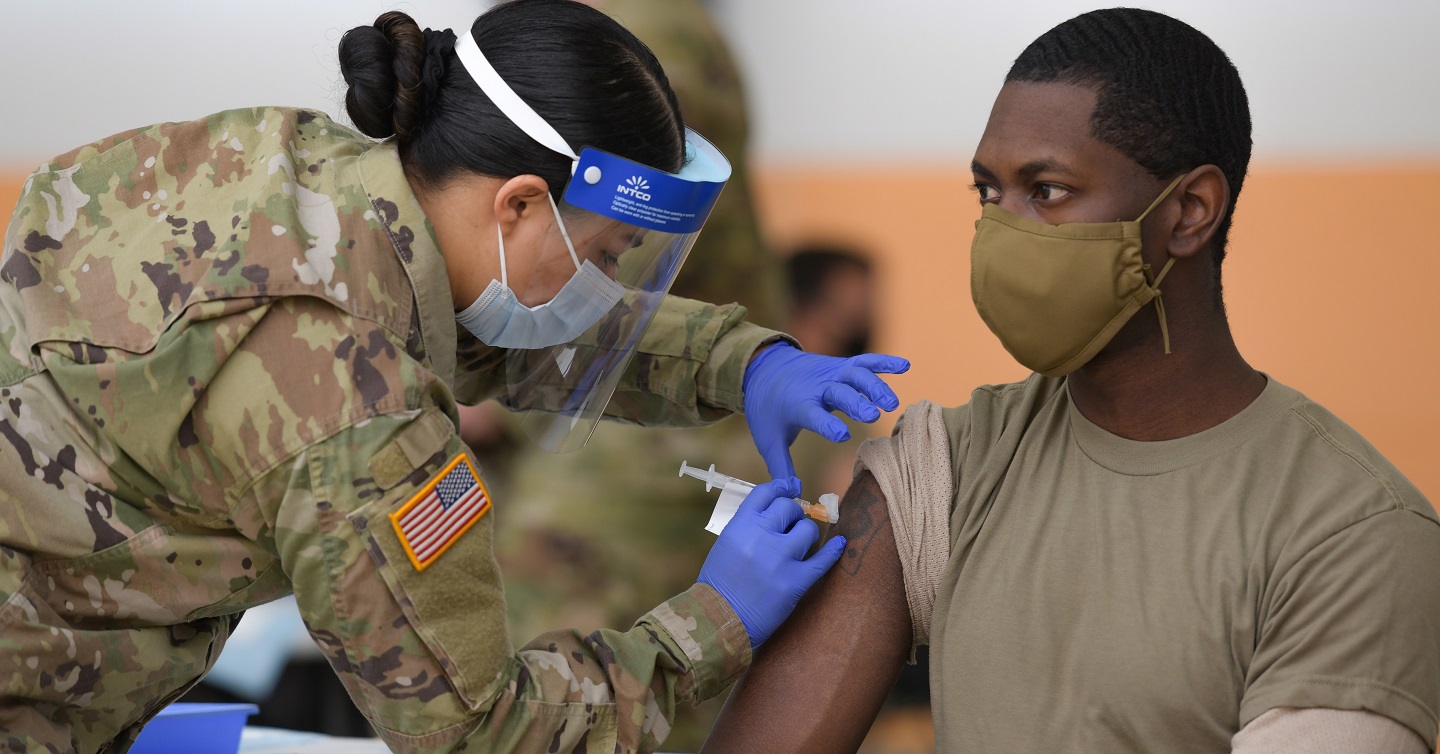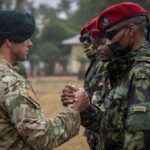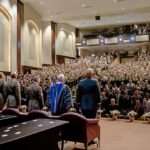
How has U.S. Army leadership ensured overseas readiness during this pandemic?
Since January 2020 and as of 6 August 2021, approximately one person (0.73) in the U.S. has died of COVID-19 every minute. The latest data from Johns Hopkins indicates that COVID-19 has caused the death of over 618,000 Americans. Worldwide, the number of deaths exceeds four million. Much of the nation’s focus has been on the military units located in United States; however, units stationed outside the nation’s borders are equally, if differently, affected by this ongoing pandemic. This difference can be attributed to the fact that those military units are few in number and are several time zones away. Managing and responding to COVID-19 calls for urgent action to address “a military readiness problem” regarding the many challenges this pandemic presents. For military units overseas, the readiness challenge presented by COVID-19 is complicated as personnel are far away from their family, multi nation direction provides significant hurdles, and plans typically emphasize actions for units stationed within the continental U.S.
How has U.S. Army leadership ensured overseas readiness during this pandemic? The experiences of the medical staff of Landstuhl Regional Medical Center (LRMC), the largest OCONUS medical center in the U.S. Military, and particularly of the Department of Pathology and Areal Laboratory Services (DPALS) offers some interesting insight into this question. LRMC DPALS has been central to the effort to maintain readiness in the face of the COVID-19 pandemic. The latest data demonstrates over an astounding 225,000 COVID tests completed in the LRMC area of responsibility, an amount that surpasses the total testing of some countries. To further highlight the volume of tests performed at the highest peak, DPALS performed 1,149 analyses in one day with a steady average of 594 samples completed per day.
Initially, in the absence of a plan to face a global pandemic of unprecedented scale, leaders and units had to scramble to implement significant reorganization efforts to address a rapidly evolving situation and remain fully mission capable while serving the region and obeying host rules within a respective area of operation. Each day, military leaders worked to fine-tune guidance, plans, programs, policies, and regulations that were reactively put into place as more and more scientific data clarifies the pandemic situation. Still readiness is being impacted and is especially painful for those troops OCONUS, either training or stationed. As an illustration, in Norway, a NATO operation was cancelled due to the fact that infection rate was too high per COVID-19 restriction guidance. Further, stop-movement orders were issued which affected training requirements and the movement of necessary troops to fill needed positions. All of these scenarios impact readiness.
In the face of these extraordinary demands, a focus on work-life balance is not an easy one to manage. To address the “life” part of work-life balance, throughout the last eighteen months, DPALS leadership has made every effort to become involved not only with active-duty service members, but also civilians, and contractors within the department. Supporting work-life balance can be done via walk-around, daily huddles, open door policy, morale welfare and recreational events, and others. This leader-intensive approach has shown dividends as DPALS has been in continuous operation throughout the pandemic and has conducted an enormous amount of testing. At the same time, the “work” portion of the equation is also being addressed by making every effort to accomplish essential operational readiness tasks such as medical and dental updates, administrative documentation checks and updates, and reinstituting regular physical fitness training modified to be compatible with COVID-19 restrictions. DPALS leadership guidance has been that during unprecedented pandemic times leaders must engage all individuals in a manner that is both logical and relevant. In practice, this means that leaders have pushed team members to think critically and have worked to empower all department personnel to find better solutions as the Army moves forward in the “new normal.”
The mental health effects of pandemic isolation and loss is a factor that will be felt by many for years to come, especially for those who experienced the pandemic overseas.
A significant point to make regarding personnel stationed OCONUS is that military personnel, civilians, and contractors are isolated from sizeable social support networks such as family and friends. The mental health effects of pandemic isolation and loss is a factor that will be felt by many for years to come, especially for those who experienced the pandemic overseas. One cannot quantify the thoughts or feelings of those in secluded foreign communities under strict host nation laws and regulations during this unprecedented time. Working from home during the pandemic provides production for both individuals and organizations, enabling both to operate in some “normal” sense; however, this approach is at the cost of individual interaction with fellow associates and colleagues. As most working individuals spend a significant amount of their lifetime at work, one can see how pandemic isolation has had a real effect on readiness.
The European theater also presents unique readiness challenges compared to the United States. Some of the unique challenges are sovereign bureaucracy that entails adhering to our North Atlantic Treaty Organization (NATO) partner’s laws and regulations in addition to laws and regulations stipulated by the United States military. The Status of Forces Agreements (SOFA) under which all service members stationed overseas operate also present unique challenges. SOFAs ensure that foreign service members abide by the laws and regulations of the host nation. In the case of DPALS, Germany’s rules are more stringent than those in the United States. For example, Germany put into place a curfew and restriction of movement to thirty kilometers or less. Thus, SOFA and movement constraints determine when, where, and how Commanders can operate. Further, logistics, manning, and joint exercises are affected, which in turn affects force readiness. These same issues affect forces in the United States; however, the more stringent laws and movement regulations are far more confining overseas, leading to more significant adverse effects upon readiness.
With increasing more virulent versions of the virus popping up, the situation in the European area of operation is evolving very quickly, and a rapid, proactive, and comprehensive approach is essential to delay transmission. The situation requires a swift shift from containment to mitigation via vaccination as a rapid increase in cases may not provide decision-makers and hospitals enough time to plan and adapt their response accordingly if not implemented immediately.
Moreover, the COVID-19 pandemic has impacted readiness from a strategic perspective as measured across manning; equipping; training; installations; and capacities and capabilities. These metrics provide data so adequate forces can be moved to meet the demands of the National Military Strategy. However, the pandemic has paralyzed Army leaders’ minds. With movement/mobility slowed to a crawl, the Army and its ability to move forces into a strategic location was at a standstill. Inelastic thinking tied to the conventional strategic metrics was the cause. In this new environment, the Army must think outside of conventional strategy and think of ways to apply our military forces towards the policy of mitigation using both social and medical science that will then in turn free up forces to be used strategically.
Readiness is not a new concept; however, during and after the COVID-19 pandemic, it will require rethinking, reorganizing, and revisioning. Possible ways forward include revisiting U.S. Army policies and contingency plans to explicitly consider future pandemics or other public health and environmental crises, in addition to planning for future conflicts and wars. The Army must produce working documents to address unexpected challenges proactively. These documents should not limit the Army’s vision or thinking to the past or the short term, but extend that vision prominently to a longer-term and more elastic variant. This work may, indeed, be happening, but these plans and products are not filtering down to the affected units with a sense of urgency. The Army must reorganize in a manner that provides maximum flexibility while maintaining a semblance of continuity. These suggestions combined with using global scientific and social data should provide a more rapid logical response that will enable the US Army to get in front of future global events such as the COVID-19 pandemic.
Greg Gharst is a Lieutenant Colonel and a Preventive Medicine Officer in the Medical Services Corps within the U.S. Army Reserve. He earned his PhD from North Carolina State University and currently serves as a Research Fellow in the Center for Strategic Learning at the U.S. Army War College.
Jose Velazquez is a Lieutenant Colonel and a Laboratory Officer in the Medical Services Corps within the U.S. Army. He earned his MS from Troy State University and currently serves as a Laboratory Manager in the Landstuhl Regional Medical Center.
The views expressed in this article are those of the authors and do not necessarily reflect those of the U.S. Army War College, the U.S. Army, or the Department of Defense.
Photo Description: U.S. Army Spc. Eyza Carrasco, left, with 2nd Cavalry Regiment, administers a COVID-19 vaccination at the 7th Army Training Command’s (7ATC) Rose Barracks, Vilseck, Germany, May 3, 2021. The U.S. Army Health Clinics at Grafenwoehr and Vilseck conducted a “One Community” COVID-19 vaccine drive to provide thousands of appointments to the 7ATC community of soldiers, spouses, Department of Army civilians veterans and local nationals employed by the U.S. Army.
Photo Credit: U.S. Army Photo by Markus Rauchenberger





We stopped or rerouted tens of thousands of soldiers and pieces of equipment in movement between four continents, ensuring our deterrent posture ..